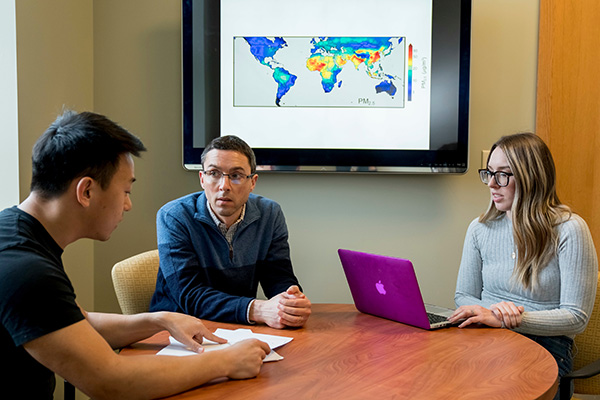Randall V. Martin is a world-renown expert in atmospheric composition and a pioneer in using global modeling to produce satellite-based estimates of fine particulate matter, the leading environmental risk factor for premature mortality worldwide.
Martin, the Raymond R. Tucker Distinguished Professor in the Department of Energy, Environmental & Chemical Engineering at McKelvey School of Engineering, points to large gaps in ground-based monitoring of fine particulate matter, known as PM2.5. In research supported by the Natural Sciences and Engineering Research Council of Canada, Martin and his colleagues proposed a way to obtain a broader, more accurate view of pollution.

“Satellite remote sensing offers valuable information to fill gaps in ground-based monitoring,” Martin says. “Research conducted at WashU focuses on evaluating and improving satellite-based PM2.5 estimates to inform regional air quality management strategies both within the U.S. and throughout the world.”
Martin’s ties to Canada run deep. He previously served on the faculty at Dalhousie University in Halifax, Nova Scotia, from 2003-2019 and was named the Arthur B. McDonald Chair of Research Excellence in 2016. At Washington University, Martin continues collaborations with scientists at Dalhousie and has gained a following of post-doctoral scholars now working in the Atmospheric Composition Analysis Group, a vibrant research hub that he directs.
Our group seeks to characterize the composition of the atmosphere through a combination of satellite remote sensing, global modeling, and ground-based measurements. Together, these activities enable us to progress in characterizing global air quality from the global scale down toward the urban and local scale as well as the interaction of the atmosphere with ecosystems and climate.
Randall Martin
Two recent papers exemplify the stunning reach and impact of the investigations Martin and his colleagues pursue:
- Emissions of fine particulate matter, PM2.5, from human activities have been linked to substantial disease burdens, but evidence regarding how reducing PM2.5 at its sources would improve public health is sparse. The authors followed a population-based cohort of 2.7 million adults across Canada from 2007 through 2016 to better understand how interventions on emission sources may improve public health in Canada. “These findings can have important public health implications globally,” they write. Impact of lowering fine particulate matter from major emission sources on mortality in Canada: A nationwide causal analysis
- In response to the September 2021 World Health Organization’s new guidelines regarding annual average outdoor concentrations of fine particulate air pollution, the authors provide a quantified analysis to accurately characterize the global health benefits of meeting the ambitious new level set by the agency. How low can you go? Air pollution affects mortality at very low levels
The World Health Organization, the World Bank, and OECD are among the organizations using data generated in Martin’s lab to inform their policy work.
Martin has been internationally recognized for his research, ranking No. 12 in the United States and No. 23 worldwide among the top 1,000 environmental scientists by Research.com and annually ranks among the world’s most highly cited researchers by the Institute for Scientific Information.
Did you know?
Ambient fine particulate matter, known as PM2.5, is the world’s leading environmental health hazard, responsible for an estimated 4.1 million premature deaths globally in 2019. With a diameter of 2.5 microns or less, PM2.5 is 30 times thinner than a human hair.
Martin and his team have conducted research on long-term effects of PM2.5 on major health risks including incident dementia in the northeastern United States, blood pressure and hypertension in Chinese children and adolescents, and mortality in the southeastern United States.
He was part of a multi-institutional study on the dangers of preharvest burning of sugarcane, a common practice in Florida that produces PM2.5, fine particulate matter that contributes to premature mortality rates in the sugarcane growing regions.
Martin serves as model scientist on the GEOS-Chem Steering Committee, which provides scientific direction to GEOS-Chem, a global 3-D model of atmospheric chemistry driven by meteorological input from the Goddard Earth Observing System (GEOS) of the NASA Global Modeling and Assimilation Office.
The model is managed by the GEOS-Chem Support Team, based at Harvard University and Washington University, with support from the U.S. NASA Earth Science Division, and the Nanjing University of Information Sciences and Technology.
Martin was installed as the Raymond R. Tucker Distinguished Professor at Washington University in March of 2023.
Surface Particulate Matter Network (SPARTAN)
The Surface Particulate Matter Network (SPARTAN) is a grass-roots network run by individual scientists working around the globe who share their data on concentrations of PM2.5 to evaluate and enhance satellite remote sensing estimates of ambient fine particulate matter in the environment.
Established in 2012 at Dalhousie University in Nova Scotia, Canada, the network expanded to Washington University in 2019, largely through the efforts of Randall Martin, a leading expert in atmospheric composition at Washington University’s McKelvey School of Engineering. SPARTAN is committed to providing research to measure and mitigate particulate matter, the leading environmental risk factor for many of the world’s diseases. It has grown to include SPARTAN sites in over 15 countries.